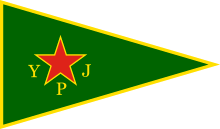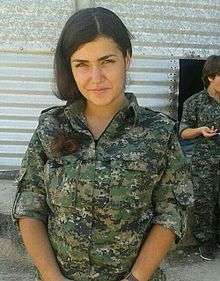Women's Protection Units
| Women's Protection Units | |
|---|---|
|
Kurdish: Yekîneyên Parastina Jin (YPJ) Arabic: وحدات حماية المرأة | |
 YPJ flag | |
| Active | March 2013–present |
| Allegiance | |
| Branch | Female service units |
| Type | Light infantry (militia) |
| Size | 5,000 (2017 estimate)[2] |
| Part of | Syrian Democratic Forces (since 2015) |
| Engagements | |
| Website | Official website |
| Commanders | |
| General Commander[3] | Nessrin Abdallah |
| Kobanî commander[4] | Meryem Kobanî |
| Aleppo commander[5] | Sewsen Bîrhat |
| Leading commander for Raqqa operations[6][7] | Rojda Felat |
The Women's Protection Units or Women's Defense Units (Kurdish: Yekîneyên Parastina Jin, YPJ, pronounced Yuh-Pah-Juh[8]; Arabic: وحدات حماية المرأة, translit. Wahdat Himayat al-Mar'a; Classical Syriac: ܚܕܝ̈ܘܬܐ ܕܣܘܬܪܐ ܕܢܫ̈ܐ, translit. Ḥdoywotho d'Sutoro d'Neshe) is an all-female military organization. It includes Kurds, Arabs, Assyrians, Circassians, and foreign volunteers.
The YPJ is the female equivalent of the People's Protection Units (Yekîneyên Parastina Gel, YPG) militia.[9] The YPJ and YPG are the armed wing of the Democratic Union Party (Syria) (PYD), which controls most of Rojava, Syria's predominantly Kurdish north.[9]
History

The organization grew out of the Kurdish resistance movement. In early March 2013, the first YPJ battalion was formed in Jandairis.[10] By 8 March, the YPJ consisted of 4 battalions: one in Afrin, one in al-Malikiyah, one in al-Darbasiyah, and one in Qamishli.[11]
As of late 2014, the YPJ had over 7,000[12] (or 10,000, according to TeleSUR)[9] volunteer fighters between the ages of 18 and 40.[12] By November 2016, the number of Arab and Kurdish YPJ fighters had reportedly risen to 20,000.[6] By March 2017, the number was claimed to have risen to 24,000.[13]
The YPJ joined its brother organization, the YPG, in fighting against groups that showed intentions of bringing the Syrian Civil War to Kurdish-inhabited areas. It has come under increased attacks from the Islamic State of Iraq and the Levant and was involved in the Siege of Kobanî.[12] YPJ continued to fight alonside YPG during further battles against ISIL as part of the Syrian Democratic Forces such as the SDF offensive against the major IS strongholds in Tabqa and Raqqa.[14] During the Turkish offensive against Afrin YPJ units were again heavily involved in the fighting.[15]
Supply
The YPJ relies on local communities for supplies and food.[12] The YPJ (along with the YPG) received 27 bundles totaling 24 tons of small arms and ammunition as well as 10 tons of medical supplies from the United States and the Kurdistan Regional Government in Iraqi Kurdistan during the Siege of Kobanî.[16]
Military operations in Iraq
The group played a critical role in rescuing the thousands of Yazidis trapped on Mount Sinjar by ISIL fighters in August 2014. One fighter said: "We need to control the area ourselves without depending on [the government] ... They can't protect us from [ISIL], we have to protect ourselves [and] we defend everyone ... no matter what race or religion they are."[17]
Ideology
.jpg)
The YPJ's ideology is democratic confederalism, as propounded by Abdullah Öcalan.[18] Having joined the YPJ, women must spend at least a month practicing military tactics and studying the political theories of Ocalan, including Jineology, a form of feminism also known as the 'science of women'.[19]
The group has been praised by feminists for confronting traditional gender expectations and redefining the role of women in conflict in the region.[12] According to photographer Erin Trieb, the YPJ is a feminist movement, even if feminism is not their main mission. She asserted that "they want 'equality' between women and men, and a part of why they joined was to develop and advance the perceptions about women in their culture".[12]
The influence of the YPJ spread to the Assyrians in Syria when the Bethnahrain Women's Protection Forces was formed as an Assyrian all-female brigade of the Syriac Military Council. Also the al-Bab Military Council, Jabhat al-Akrad and Jabhat Thuwar al-Raqqa have established their own female units.[20][21]
Significance in Syrian Civil War
Various Kurdish media agencies indicate that "YPJ troops have become vital in the battle against I.S." in Kobanî.[9] YPJ achievements in Rojava have attracted considerable international attention as a rare example of strong female achievement in a region in which women are heavily repressed.[22][23][24][25][26][27]
See also
References
- ↑ "PYD announces surprise interim government in Syria's Kurdish regions". Rudaw. 13 November 2013. Retrieved 9 October 2014.
- ↑ Rashid (2018), p. 16.
- ↑ "Syrian Kurds' morale high but arms needed, YPJ commander". ANSAMed. Retrieved 31 July 2015.
- ↑ "Interview with YPJ Commander in Kobane and Mishtenur Hill". 17 November 2014. Retrieved 13 November 2013.
- ↑ "Aleppo: New Group of YPG/YPJ Fighters Graduated from Training Course". YPG Rojava. 23 April 2015. Archived from the original on 18 May 2015. Retrieved 2 May 2015.
- 1 2 Moritz Baumstieger (9 November 2016). "Profil - Rojda Felat. Kommandeurin der Offensive gegen den IS in Raqqa und Bismarck-Fan. [Profile - Rojda Felat. Commander of the offensive against the IS in Raqqa and Bismarck-Fan]". Süddeutsche Zeitung (in German). Retrieved 1 January 2017.
- ↑ "Wrath of Euphrates Operations Room, commandant Rojda Felat, Northern Raqqa". YPG. 10 December 2016. Retrieved 1 January 2017.
- ↑ "#YPJ Female Fighters Shaking #ISIL... - The Lions Of Rojava". facebook.com. Retrieved 4 December 2015.
- 1 2 3 4 "Kurdish Women Turning Kobani into a Living 'Hell' for Islamic State". Telesurtv.net. 14 October 2014. Retrieved 21 October 2014.
- ↑ Jan Kalan (3 March 2013). "Formation the first battalion of women's protection units in western Kurdistan".
- ↑ "The fourth female military battalion have been formed in Western Kurdistan". Western Kurdistan. 8 March 2013.
- 1 2 3 4 5 6 "YPJ: The Kurdish feminists fighting Islamic State". The Week UK. 7 October 2014. Retrieved 21 October 2014.
- ↑ "Exclusive: Syrian Kurdish YPG aims to expand force to over 100,000". Reuters. 20 March 2017.
- ↑ "The commander Clara: 4 stages achieved their aims". Hawar News Agency. 7 June 2017. Archived from the original on 2017-10-09. Retrieved 2018-02-09.
- ↑ Nordland, Rod (30 January 2018). "Female Kurdish Fighter Kills Turkish Troops in Likely Suicide Bombing in Syria" – via NYTimes.com.
- ↑ Istanbul, Constanze Letsch in. "US drops weapons and ammunition to help Kurdish fighters in Kobani". the Guardian. Retrieved 31 December 2015.
- ↑ "These Remarkable Women Are Fighting ISIS. It's Time You Know Who They Are". Marie Claire. Retrieved 21 October 2014.
- ↑ Argentieri, Benedetta (3 February 2015). "One group battling Islamic State has a secret weapon – female fighters". Reuters. Retrieved 24 November 2016.
- ↑ Argentieri, Benedetta (30 July 2015). "These female Kurdish soldiers wear their femininity with pride". Quartz (publication). Retrieved 24 November 2016.
- ↑ "Inspired by Kurdish units, al-Bab Military Council creates all-female battalion - ARA News". 1 November 2016. Archived from the original on 5 November 2016. Retrieved 24 November 2016.
- ↑ "بيان إلى الرأي العام".
- ↑ "Female Kurdish fighters battling ISIS win Israeli hearts". Rudaw. Retrieved 8 March 2015.
- ↑ "The Fight Against ISIS in Syria And Iraq December 2014 by Itai Anghel". The Israeli Network via YouTube. 22 December 2014. Retrieved 8 March 2015.
- ↑ "Fact 2015 (Uvda) – Israel's leading investigative show". The Israeli Network. 22 December 2014. Archived from the original on 26 February 2015. Retrieved 8 March 2015.
- ↑ "Kurdish female fighters named 'most inspiring women' of 2014". Rudaw. Retrieved 8 March 2015.
- ↑ "Kobani: How strategy, sacrifice and heroism of Kurdish female fighters beat Isis". International Business Times UK. Retrieved 8 March 2015.
- ↑ "Meet The Kurdish Women Fighting ISIS". All That Is Interesting. 11 June 2015. Retrieved 16 October 2016.
Bibliography
- Rashid, Bedir Mulla (2018) [1st pub. 2017]. Military and Security Structures of the Autonomous Administration in Syria. Translated by Obaida Hitto. Istanbul: Omran for Strategic Studies.
External links
| Wikimedia Commons has media related to YPJ. |